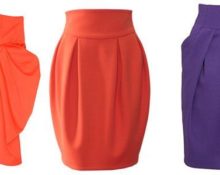 These skirts are universal. Thanks to the variety of different textured fabrics, you can sew completely different skirts using just one pattern.
These skirts are universal. Thanks to the variety of different textured fabrics, you can sew completely different skirts using just one pattern.
Let's look at a variety of skirt models.
Selection of materials
Pleated skirts can be made from either dense, structured fabric or light, airy fabric.
 The list is as follows:
The list is as follows:
- plaid;
- tweed;
- natural, artificial suede;
- drape;
- light coat fabrics for winter models;
- gabardine;
- wool;
- coarse flax.
When sewn, these materials will give a clear geometry. Plaid is a resilient skirt classic.
 If you are interested in skirts that flow around the legs, giving lightness, then use less dense types of fabrics:
If you are interested in skirts that flow around the legs, giving lightness, then use less dense types of fabrics:
- silk;
- crepe – georgette, crepe-satin;
- viscose;
- batiste;
- chiffon.
 In this case, keep in mind that the corners will not be so clearly defined and the shape of the skirt will be softer, more vague.
In this case, keep in mind that the corners will not be so clearly defined and the shape of the skirt will be softer, more vague.
Advice! Not one-piece skirts look expressive, but those with stitched panels, sewn from fabric of contrasting colors.
Types of folds
The following options are available:
- Circular – located in one direction. All other types are built on the basis of this type.
- Counter – the tops of the simple folds that form a complex fold are directed face to face.
- Bow – the folds of the folds that form one complex one “look” in different directions.
- Fan – diverging from one point.
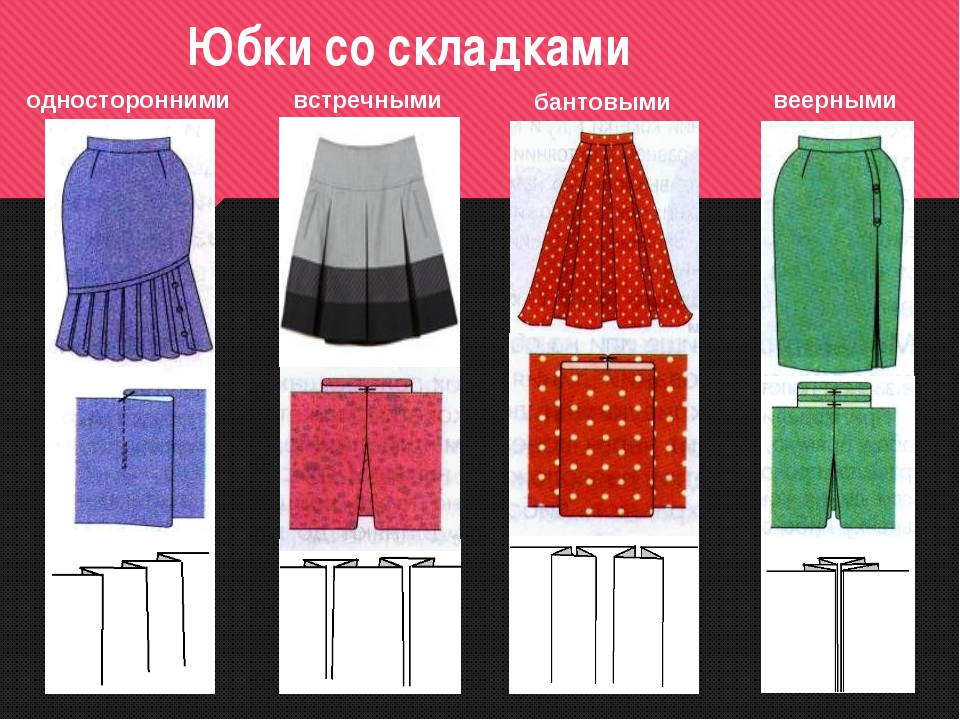 Depending on the manufacturing method:
Depending on the manufacturing method:
- Stachnye – they are stitched, that is, they are joined with a seam, along the inconspicuous side of the fold.
- Adjustment – The connecting seam runs along the front, visible side, performing a decorative function.
Advice! Stitching in such cases is often done with contrasting threads. It is possible to use program decorative stitches.
- Connecting - a method of inconspicuously joining cut parts; the seam is made along the hidden side of the fold.
Measurements
To build any type of skirt, the following measurements are required:
- Waist circumference. At the narrowest point of the body.
- Hip girth. Measured around the hips.
- Thigh height. Measured along the side, from the waist to the hip line.
- Skirt length. From the waist line to the line of the expected hem of the skirt.
Features of fold processing
 Bow:
Bow:
- We sew the entire width of the fold along the outside.
- Iron it out to create a wide, flat surface.
 Circular:
Circular:
- Set the depth of the fold.
- Sew to the required distance.
- Turn in the right direction.

- If necessary, topstitch with decorative stitching.
 Partially stitched pleats look like this:
Partially stitched pleats look like this:
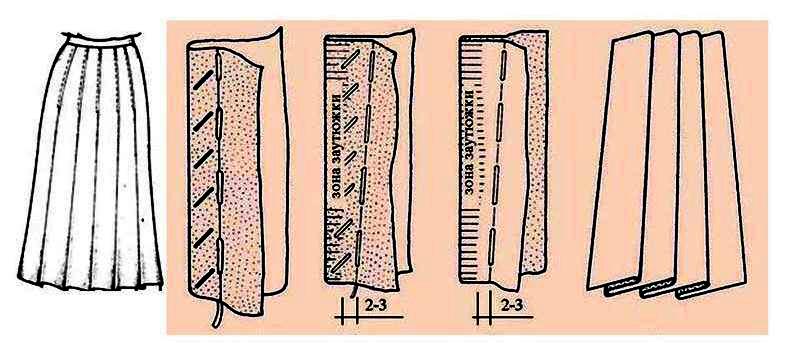 Counter
Counter
Most often it is located singly, in the center of the skirt:
- Two simple single folds are laid with a fold towards each other.
- Foldable.
- Stitched to the required distance, or tucked into the belt.
 Fan
Fan
Single, can be located in any part of the smooth panel, most often in the center of the front or along the back seam:
- Splines are often used as an element.
- Mark the folds.
- We fold several one-sided folds on top of each other.
- On the other hand, we act in a mirror way.

Advice! To prevent significant thickening of the product from numerous layers of fabric, excess material above the fold is removed.
Calculation of folds

For a skirt with circular pleats, there is a formula for calculating their depth.
 To do this you need to know:
To do this you need to know:
- Fold width (Ws)
- Hip volume (V).
- Number of folds (KS).
KS=(OB+Shs)/Shs
If your waist size is 80 cm, and you want the fold width to be 4 cm, then your calculations will look like this:
KS=(80+4)/4=21 pieces
On the other hand, the panels of the front and back halves of the skirt are the same; you can simply carry out all the calculations and markings on one quarter of the skirt. This applies to cases where, in addition to complex elements, there are also smooth areas.
Fabric calculation

To find out how much fabric is needed for folds, you need to take into account that the fold is double, which means we multiply its size by 2 times.
 To calculate the fabric, you need to multiply your hip volume by 3, plus 10 cm for allowances.
To calculate the fabric, you need to multiply your hip volume by 3, plus 10 cm for allowances.
Of course, you need to consider the length of the skirt.
Since the width of the panels is very large, a skirt with a large number of folds must be sewn from several cuts.
Pattern-base step by step

Let's figure out how to make a base pattern yourself:
- We take measurements.
- Select the type of folds and their number.
- Draw folding lines onto the base pattern.
- Increase by the required amount.
- How the base pattern changes with different types of folds is shown in the figure.
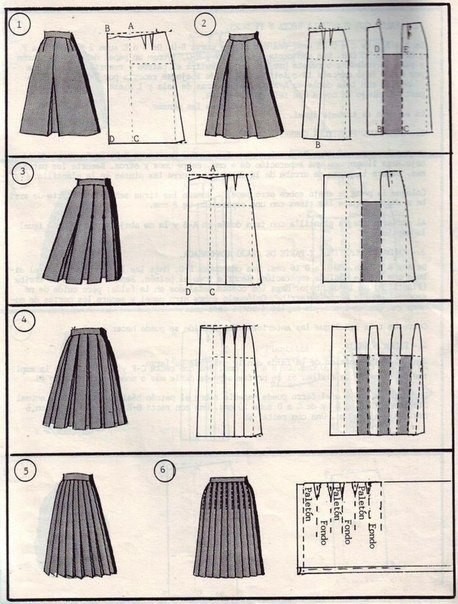
- We draw a new pattern for the panel, taking into account all the changes.
Other options:
On the yoke.
 Very wide at the waist.
Very wide at the waist.
Skirt with bow pleats

Required:
- skirting;
- interlining;
- zipper;
- button;
- matching threads.
Progress:
- We cut out the panel and belt.
- We duplicate the belt with non-woven fabric.
- Mark the folds.

- We pin it with pins.
- Baste along the top edge of the skirt.

- Leave some space for the zipper.
- Let's try it on.
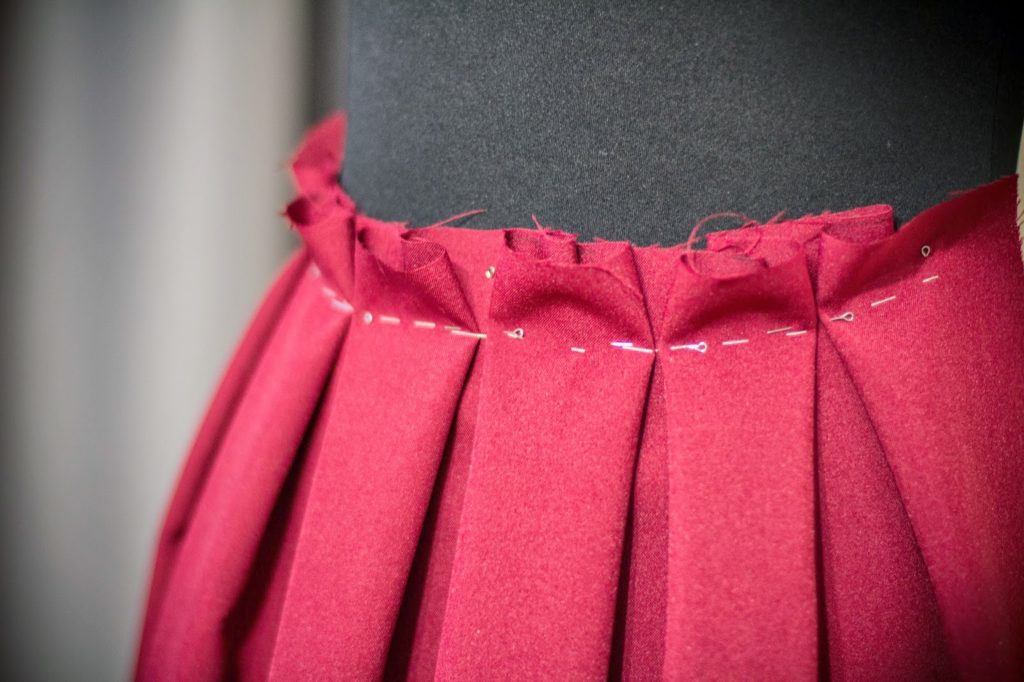
- We sew in a zipper.
- We sew on the machine along the basting line.
- We sew the belt.

- Sew the belt to the skirt.
- Punch a buttonhole.
- Sew on the button.
- Steam the product.
- Let's try it on.
The folds can be located on the skirt panel directly under the belt or under the yoke. There are no design features in this case. Thus, using basic design knowledge, we obtain a variety of styles.


 1
1



